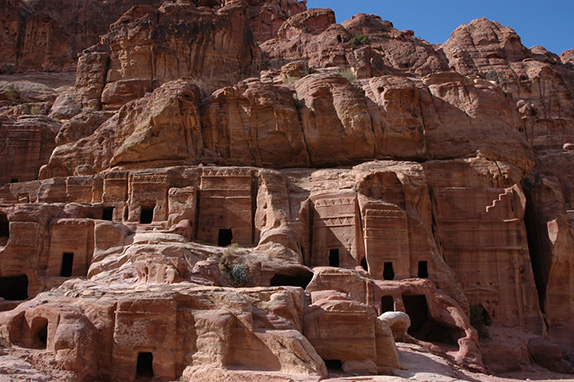 (Petra)
(Petra)
About a decade ago I was visiting New York, and took one of my grandchildren to the Museum of Natural History. The featured exhibition was on Petra, the mysterious Nabataean ruin in today’s Hashemite Kingdom of Jordan. Maps, photographs, paintings and archeological pieces pulled me into a world that spoke to me. One simplified square mask, considerably larger than life, was particularly compelling. Right then and there I decided I would find a way to visit Petra.
Which turned out to be more difficult than I anticipated. When I went on line looking for travel agencies that could help me plan a trip anywhere in the Middle East, the options were minimal. There were a half dozen that advertised journeys to the Holy Land. Agencies in London and Amsterdam proved more adventurous. None spoke to my need. Then a light bulb went on: I realized Jordan must have its own travel agencies. A quick search took me to Petra Moon, located in the village next to the ruin. My inquiry brought an immediate response, and soon I was emailing back and forth with a very amiable contact happy to help me design exactly the trip we wanted.
I mention Petra Moon because I will never forget the extraordinary experience they provided, or the fact that they refused payment until after our visit (“otherwise, how would we know you enjoyed yourself”). When, on site, we asked for an extra day in the ruins, they made the change without charge. But what I really want to talk about here is Petra itself, the Nabataeans who established the site in 312 BC, and how water shaped their lives and political policies.
In today’s world, water is always problematic. Ice caps melt, seas rise, and small island nations are threatened with extinction. Sometimes it rains too much too quickly, producing devastating floods. A river like the Mississippi—that carries a third of the nation’s commerce—either dries to the point where its shipping lanes must be reduced or overflows its banks. Out-of-control development and industry refuse to take water tables into account, threatening a future burdened with problems ignored when rational planning might have avoided them. And water tables are also threatened by mining, fracking, and other chemical irresponsibility. Extreme greed is behind this uncontrolled development, just as it is behind our refusal to take climate change seriously and come together to meet it with viable solutions.
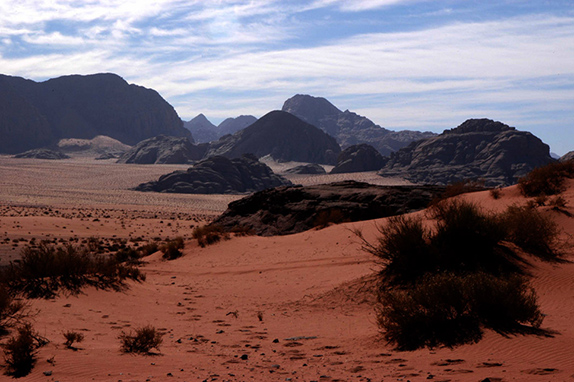 (Jordan’s Wadi Rum)
(Jordan’s Wadi Rum)
Drought in the United States threatens another Dust Bowl. Images of dark skies, cracked earth, withered crops and dying animals bring memories of a time some of us still remember. Drought in some of the African countries, Australia, and elsewhere in the world has brought destructive fires and requires the emergency action of international aid organizations. But the water must come from somewhere. Bottled water has become a multi-billion dollar business. It has often been said that the wars of the 21st century will be over water, as those of the 20th were over oil.
But it wasn’t always like this. We look to ancient civilizations and try to imagine how their people lived, what solutions they found to some of the problems with which we continue to struggle. Their failures, or what we perceive as their failures, stand as warnings to us. Most often we come away with a smug sense of “knowing more,” and believe we understand what happened to them as well as vowing not to overuse or destroy our own precious resources. And then we do just that.
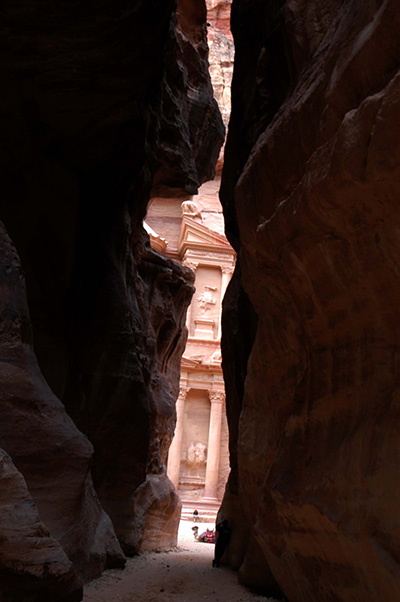
(Emerging from Siq, first glimpse of Petra)
In Petra we have the example of a people who never had to go to war to defend their home or to avoid being conquered. They had ample water sources, devised ways of storing and moving it, and made themselves an important stop along the Silk Road, where they traded one-third of what the camels carried for enough water to send them on their way. In exchange for water, they acquired precious metals, spices, and other necessities.
Petra lies on the slope of Mount Hor, rich in springs and streams. Hidden in a narrow valley, its whereabouts were unknown to the Western world until 1812, when Swiss explorer Johann Ludwig Burckhardt had heard rumors of its existence, disguised himself in local dress, and managed to make his way through the tall rock walls of the Siq and view the vast panorama of rose pink tombs. The Siq (meaning “shaft” in Arabic) is a natural geological feature formed from a deep split in the sandstone and serving as a waterway flowing into the Wadi Musa.
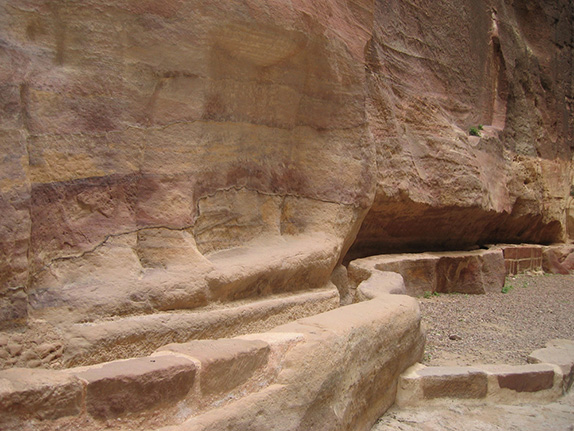 (Ancient water channel carved the length of the Siq)
(Ancient water channel carved the length of the Siq)
Natural waterways can mean floods. Although most famous for having carved monumental palaces and intricate tombs over acres of land, perhaps the Nabataeans’ greatest achievement was learning to control and preserve the water supply that led to the rise of their desert city. They created an artificial oasis. The area always hosted flash floods, but the Nabataeans managed these with dams, cisterns and water conduits. These innovations stored water for prolonged periods of droughts and enabled the city to profit from selling the excess. Making one’s way through the quarter mile of the Siq, from the outer edge of the present-day village into the ruin itself, one can still see the waist-high trough that once carried the precious liquid. In several places throughout the ruin one can also look down through iron grates into vast cisterns.
Through the centuries, Petra experienced a series of changing influences. The city is mentioned in the book of Exodus, when the Horites inhabited the area. Then came the Edomites, and later Egyptian, Greek, and Roman cultures predominated. Just before World War I, a small force of Syrians and Arabians, led by Lawrence of Arabia, successfully defended the city against a much larger contingent of Turks and Germans. Bedouins lived in Petra’s caves until modern-day tourism forced them into government housing; many of these local people (including our Bedouin guide) prefer their more traditional habitats, and sneak back into the World Heritage site to sleep there at night.
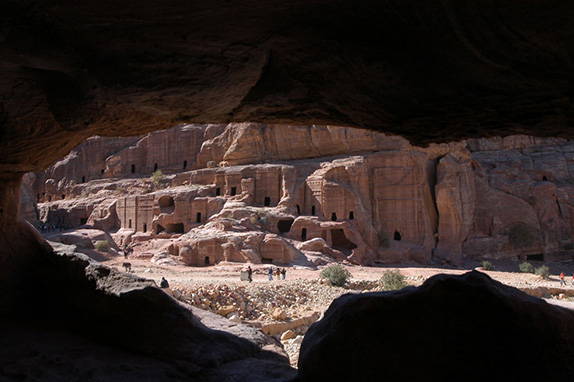 (Photo taken from one of the caves at Petra)
(Photo taken from one of the caves at Petra)
According to the 2011 Human Development Report, Jordan is listed as an emerging market with the third freest economy in West Asia and North Africa. It is a founding member of the Arab League and of the Organization of Islamic Cooperation, and enjoys “advanced status” with the European Union since December 2010. Women seem to have more freedom than in most Arabic countries. We visited several flourishing women’s cooperatives, saw female police, and read articles about outstanding women in a variety of fields. Undoubtedly, US American-born ex Queen Noor had a great deal to do with the increase in women’s rights.

(Partial statue in Siq)
Jordan has a long history of taking in refugees. A mix of cultures continues to enrich the country. Almost two million Palestinians have made their homes there, approximately one-fifth of them still living in refugee camps. Jordan has offered citizenship to all Palestinians who wish to acquire it. Since the US invasion of Iraq, almost a million Iraqis live in the country as well. Despite the many problems inherent to such immigrations, it would seem that contemporary Jordanians honor a tradition begun many centuries ago, that of peaceful co-existence rather than racist conflict. One small example of the importance placed on trust was evident to us when we noticed open stalls selling woven goods, silver and other crafts. These stalls remained unattended throughout the night. It was clear that stealing was not a problem.
Petra’s waterways and the philosophy by which the resource was managed in ancient times stand as symbols of creative cooperation we might do well to emulate. Rather than the manipulation that comes from greed, rather than fighting and killing over its possession, the Nabataeans knew how much water they had and engaged in careful planning that brought peace and prosperity for centuries.
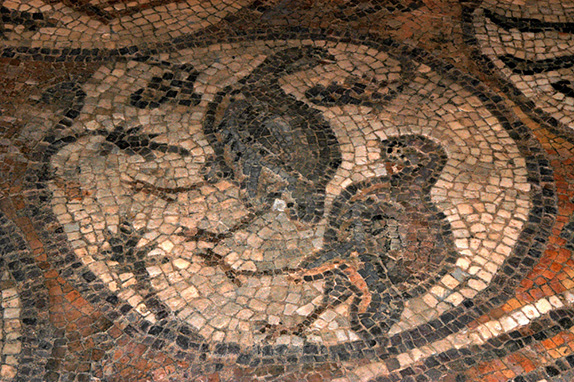 (Mosaic floor, Petra)
(Mosaic floor, Petra)

May 24, 2013